Why is that?
Because if there's a site that's pretending to be a legit site, you really want to know about it as a user!
Look, a secure connection to the attacker is no damn good at all, and every man and his dog can make a self-signed certificate. There's no inherent trust in a self-signed cert from anyone, except for the trust roots you've got installed in your browser. The default set of trust roots is picked (carefully!) by the browser maker with the aim that only CAs who only act in a way to secure trust will be trusted by the system, and this mostly works. You can add your own trust roots too, and if you're using a private CA for testing then you should.
This strongly discourages web developers to use an awesome technology like SSL out of fears that users will find the website extremely shady. Ilegitimate (ie: phishing) sites do fine on HTTP, so that can't be a concern.
What?! You can get a legit certificate for very little. You can set up your own trust root for free (plus some work). Anyone developing and moaning about this issue is just being lazy and/or over-cheap and I've no sympathy for such attitudes.
Ideally a browser would look for information that you want kept secure (such as things that look like credit card numbers) and throw that sort of warning up if there was an attempt to send that data over an insecure or improperly-secured channel. Alas, it's hard to know from just inspection whether data is private or not; just as there's no such thing as an EVIL bit, there's also no PRIVATE bit. (Maybe a pervasive metadata system could do it… Yeah, right. Forget it.) So they just do the best they can and flag up situations where it is extremely likely that there's a problem.
Why do they make it look like such a big deal? Isn't having SSL even if untrusted better than not having it at all?
What threat model are you dealing with?
Browser makers have focused on the case where anyone can synthesize an SSL certificate (because that's indeed the case) and DNS hacks are all too common; what the combination of these means is that you can't know that the IP address you've got for a host name corresponds to the legitimate owner of that domain, and anyone can claim to own that domain. Ah, but you instead trust a CA to at least check that they're issuing the certificate to the right person and that in turn is enough (plus a few other things) to make it possible to work out whether you're talking to the legitimate owner of the domain; it provides a basis for all the rest of the trust involved in a secure conversation. Hopefully the bank will have used other unblockable communications (e.g., a letter sent by post) to tell people to check that the identity of the site is right (EV certs help a little here) but that's still a bit of a band-aid given how unsuspicious some users are.
The problems with this come from CAs who don't apply proper checks (frankly, they ought to be kicked off the gravy train for failing their duty) and users who'll tell anyone anything. You can't stop them from deliberately posting their own CC# on a public message board run by some shady characters from Smolensk[1], no matter how stupid an idea that is…
[1] Not that there's anything wrong with that city. The point would be the same if you substituted with Tallahassee, Ballarat, Lagos, Chonqing, Bogota, Salerno, Durban, Mumbai, … There are scum all over.
